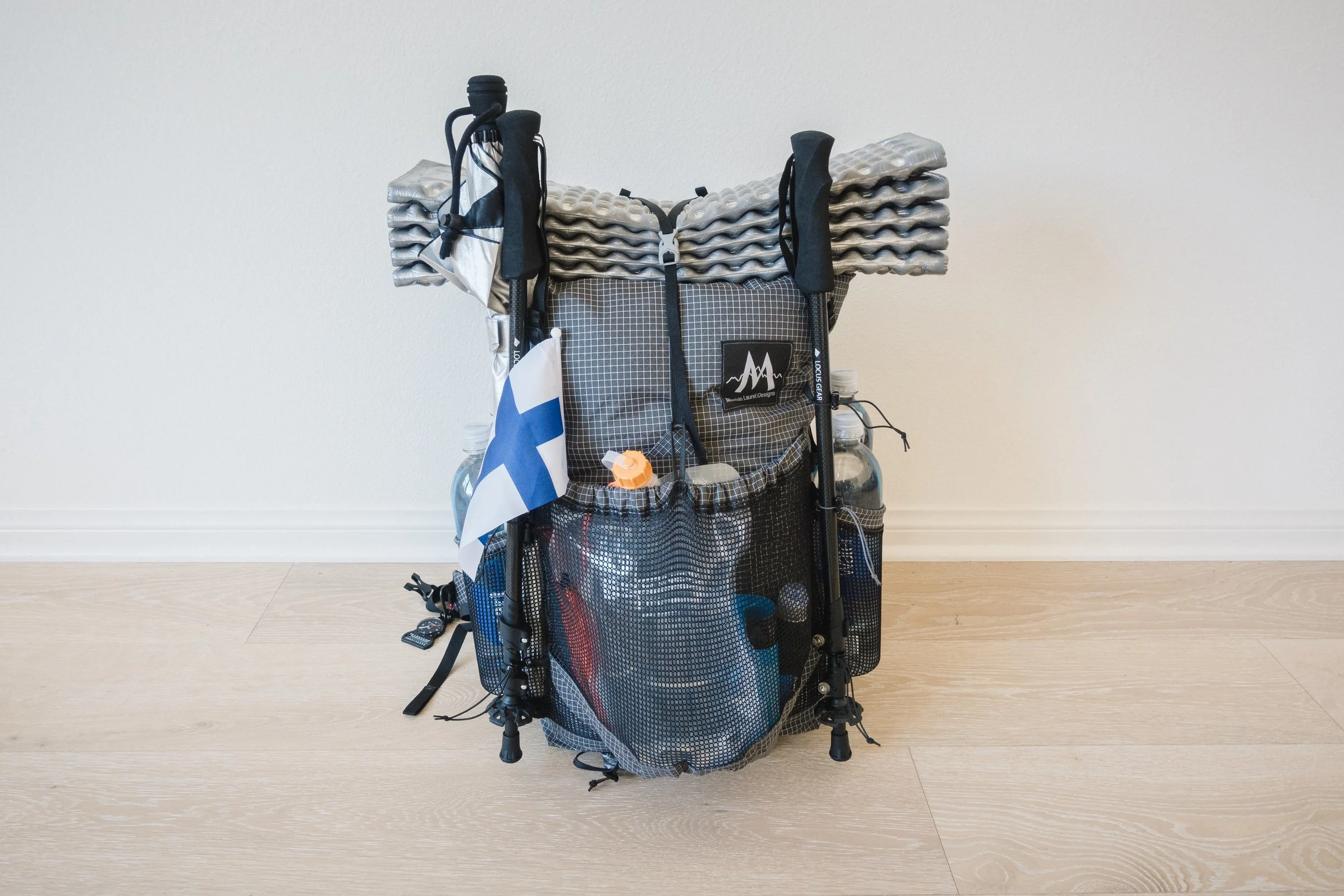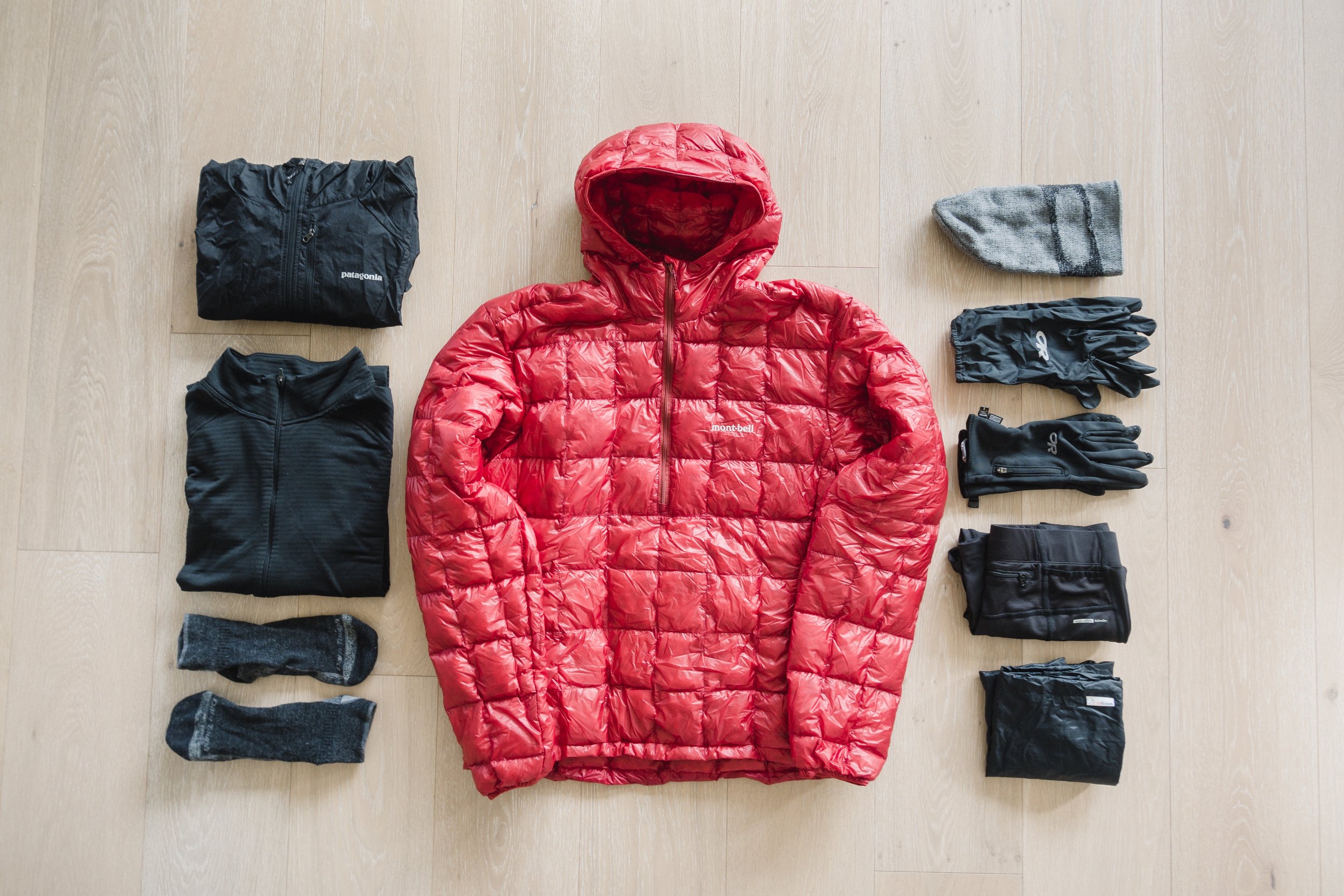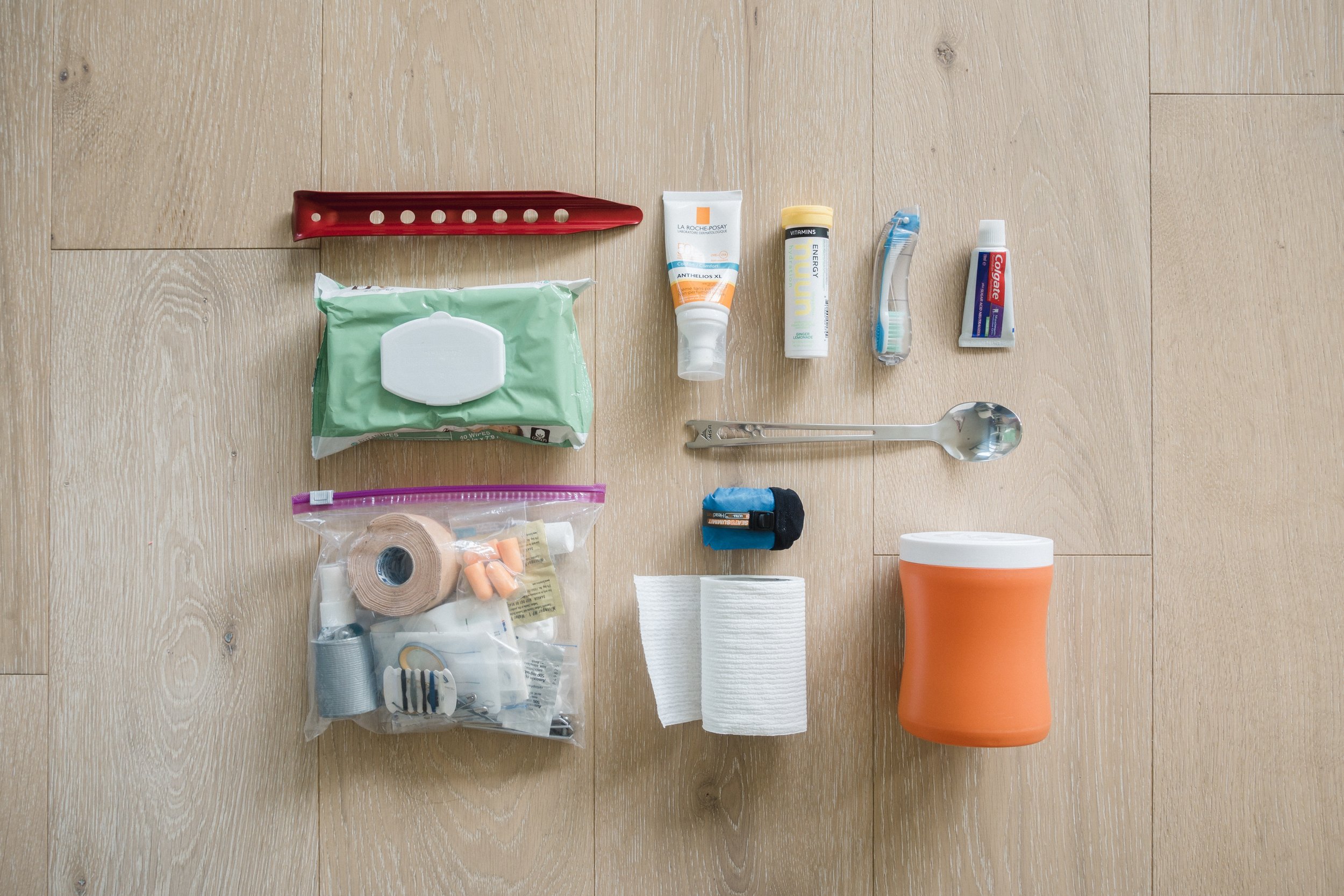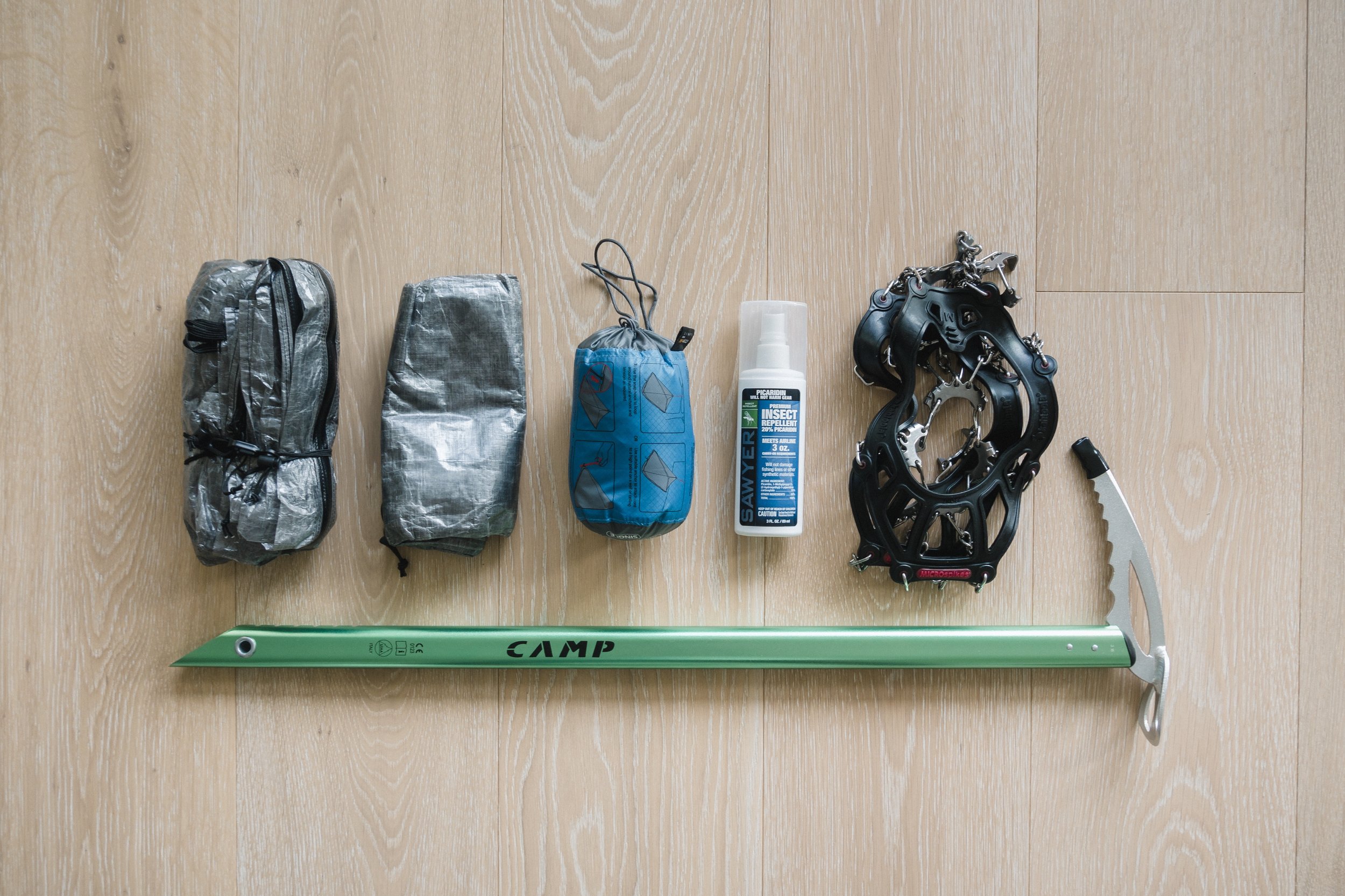My Pacific Crest Trail thru-hike gear list
Long distance thru-hiking is undoubtedly a gear sport. What you bring, and what you leave at home, can make a huge difference not only to one's comfort on the trail, but also ultimately to either making or not making it. Lightweight and multi-use are the name of the game.
Here are all the gear I will be bringing along for my PCT thru-hike, sorted out by category. I've also included some reasoning on why I chose to take these, or why I chose to leave something out. I've also include item weights where it makes sense in the context of this article.
For more detailed breakdown, see my full gear list on my lighterback page.
The Big Three
The Big Three consists of your shelter, sleep system, and backpack. These are usually the heaviest items you carry, and also where you can save the most weight.
My backpack is Mountain Laurel Designs Prophet (463g). It's a 48L frameless pack (meaning, unlike generally, it doesn't have a frame inside) and carries really well. I've attached MLD's Bottle Pocket shoulder pouch to the right shoulder strap, and ZPacks Shoulder Pouch to the left where I keep my camera and camera accessories for easy access while hiking.
For shelter I use MLD's cuben fiber Patrol Duo (310g), coupled with cuben fiber Serenity Duo (310g) innernet. While ZPacks and Big Agnes are the most popular shelter brands on the PCT, I chose to go with the Patrol tarp for its modularity and openness. Unlike the ZPacks shelters, with the Patrol, you can pitch just the innernet, or the tarp, or both – depending on the weather and bugs. And unlike the fully enclosed tents from Big Agnes, the tarp offers a bit more "scenery" and allows you to be more connected with your surroundings.
For sleeping bag I use the ZPacks 10F sleeping bag (709g). Up until the last minute I was going to use my old 20F bag, but seeing how many of the 2016 thru-hikers complained that it was too cold, and looking at all the snow on Sierra, I ordered the warmer 10F bag. I should sleep nice and warm.
My sleeping pad is the good old Z Lite Sol (260g) from Therm-a-Rest. While I enjoy the comfort of inflatable pads, on longer hikes I get tired of inflating and deflating them. You can just throw down the Z Lite and you're ready to sleep, no huffing and buffing required. The Z Lite is also almost indestructible, which is great when you're crossing 800 miles of desert full of poky things looking to puncture your pad. I've cut the Z Lite to about torso length to save some weight and space.
I'll also bring a strip of tyvek (98g) for cowboy camping and GooseFeet Gear's down pillow (68g) as a luxury item.
Clothing I wear while hiking
All my Patagonia clothing and gear comes from Camu, my favorite outdoor gear store in Finland. They were kind enough to sponsor my thru-hike and have been nothing but amazing! Check them out online here, or if you're in Helsinki, visit their store in Kaisaniemi.
--
I love hiking in shorts. For the past couple of years I've tried all kinds of different shorts and finally found the Patagonia Strider Pro 5 shorts. They are a great compromise between having enough pockets, and still being minimal and staying out of your way.
For the shirt I'm starting with the Columbia Silver Ridge long sleeve shirt. It had great online reviews and from all the shirts I tried on at REI, I liked the Silver Ridge the most.
On my feet I wear Darn Tough 1/4 hiker socks, Dirty Girl gaiters to keep the debris and sand out of my shoes, and Brooks Cascadia 11's will be my go-to shoe from the start. I might switch to 12's at some point along the way.
This year I'm also testing out a fanny pack. I don't like to have hip pockets on my pack as they get in my way, so I needed a solution to have my snacks and other small items easily accessible while hiking – enter Thru Pack. I ordered the cuben fiber Astronaut (43g) with the Comfy Strap upgrade and so far I'm loving it. It fits a ton of snacks and small gear, is easily accessible at all times, weights almost nothing, stayes out of way while hiking, and when in trail towns I can use it to carry small items and camera gear around town.
I cover my head with a standard Patagonia Trucker hat and use the UV/Insect Shield Buff for bandana/neck warmer/beauty goggles/towel. For extra sun protection I use the umbrella.
Clothing packed
In southern California it's going to be mainly windy, so the Patagonia Houdini jacket (102g) is going to come handy. With the DWR protection, coupled with the umbrella, it can also withstand light rain. The As Tucas Millaris pants (57g) work as windpants, and against the mosquitoes in the Sierra and Oregon.
I'll use the Patagonia Capilene Thermal Weight Zip-Neck (175g) for cold nights and when I need some extra warmth on the trail. For the same purpose I have the Salomon AdvancedSkin ActiveDry tights (180g). I can also wear the tights under my shorts, which comes handy on Sierra and when glissading.
Montbell Ex Light Down Anorak (177g) works as my insulation layer. I chose the Ex Light instead of the ever popular Ghost Whisperer as it's cheaper and in my opinion provides better value.
When it gets cold, I'll keep my extremities warm with OR Versaliner Gloves (75g), extra pair of Darn Tough socks (65g), and a general Oakley beanie (64g) I've always used.
Cooking gear, hygiene, and first-aid
My personal hygiene kit consists of baby wipes, TP, and MSR Blizzard Tent Stake (28g) which I use as a trowel (meaning, to dig holes to poop in). Then a toothbrush, toothpaste, and sunscreen and electrolytes for desert hiking.
My first-aid kit is pretty simple. There's just some Leukotape, water treatment tablets as a backup, vitamin I, and items for blister treatment.
As I’m hiking stoveless, meaning I'm not using a stove to heat or prepare my food, my cooking gear is quite simplistic. I use the empty Gatorade container to hydrate my meals in, or as a mug, and my spoon as a, well, spoon.
I’ll start with the ZPacks cuben fiber food bag (not pictured here), but if the critters get really bad, I’ll probably switch to Ursack with OPSak. In the Sierra I’ll use the mandatory bear can for food storage.
Why I’m going stoveless?
I’ve noticed that, especially on longer hikes, I really don’t enjoy hot foods. Also, not having to boil water and wait for it to cool saves time, and not having to carry the stove or the fuel saves weight.
Camera gear and electronics
This is the hardest category for me personally and it's way too heavy, but I just can't cut anything from the list.
The DeLorme inReach SE 2-way satellite communicator (203g) keeps me connected when there's no cell signal, and keeps my parents happy as they can follow my progress on a map where the inReach sends a ping every 10 minutes. It also allows me to call and communicate with Search and Rescue if something would happen while on trail.
iPhone 7+ (188g) is for editing photos and video, writing and publishing these blog posts, and generally communicating while there's a signal. Apple's Lightning to USB 3 Camera Adapter (22g) is used for transferring photos and video from the Sony RX100 V (not pictured here, 299g) to my phone.
Pedco UltraPod tripod (56g) is used for stability, and StickPic Adapter for selfies (11g).
As I will be doing lots of night hiking, I opted for the heftier, Scandinavian winter quality headlamp. The 300 lumens from the Petzl Reactik+ (115g) is more than enough for the PCT, but as I already owned one, I didn't want to buy a headlamp just for the PCT. It should at least make it easier to see all the rattlesnakes and mountain lions ahead.
Suunto Spartan Ultra All Black Titanium (73g) watch is used for easily seeing the distances while hiking, seeing elevations, and generally assessing where I'm at on the trail without having to take out the map constantly.
All these are powered by Anker PowerCore Speed 10000 QC (200g) battery pack and Suntactics S5 (202g) solar charger. Why I chose to go with a smaller, 10,000mAh battery pack and solar charger, is a compromise between weight, need for power, and time spent in towns. The smaller battery pack and solar charger combo weights about 400g, the same as a larger, 20,000mAh battery pack. But while the smaller battery pack takes about 3,5 hours to charge, the larger one takes up to 8-9 hours. This means that you're stuck in a trail town every 4 to 5 days waiting for your battery pack to recharge. With the smaller battery pack and solar charger combo I can just do my resupply and quickly get on my way. It should be noted that if you bring less electronics than me, none of this is an issue and you can easily get away with just the smaller battery pack.
I'm also bringing along a 4-port wall charger, the Anker Quick Charge 3.0 (141g) as wall outlets in trail towns are in high demand. With this, I can charge all my electronics from a single outlet.
Hydration & other gear
For the water carriage at the beginning, I have a 6L capacity. I'll use a 2L Evernew bladder and four 1L Smart Water bottles. Smart Water bottles are great as they have the same threading as the Sawyer Squeeze water filter (65g). They are also strong, light, and easily available anywhere on the trail. For backflushing the Sawyer Squeeze, I'm using the sports drink cap from the 0,75L Smart Water bottle. This way I can leave the heavy backflush syringe at home.
For trekking poles I'm using Locus Gear's CP3 carbon fiber poles. I also use them to pitch my shelter.
Liteflex umbrella is used as sun protection in the desert, and as light rain protection.
My old SpyderCo Dragonfly knife is again coming with me. They make one that uses plastic for the body, and it's half the weight, but I just couldn't make the switch as this knife has been with on all my adventures.
Gear for the Sierra
Most thru-hikers ship their Sierra gear to Kennedy Meadows which is the last resupply stop before the Sierra's start. My Sierra gear consists of: Camp Corsa ice axe (205g), ZPacks cuben fiber Rain Poncho (144g), DIY cuben fiber rain skirt (55g), Sea to Summit Nano Mosquito Net (82g), Sawyer Picaridin Insect Repellent, and Kahtoola MICROspikes (338g). For the reguired bear canister, I'll use the BearVault BV500 (1160g) which I'll buy from the Kennedy Meadows store.
My gear list will probably change during the hike, and that's fine. I'll make an "after the hike" gear list to compare what changed, and why.
I'm leaving for the trail tomorrow morning, so the next time you'll be hearing from me will be from the trail. You can follow along on my dedicate PCT blog page or following me on Instagram.








